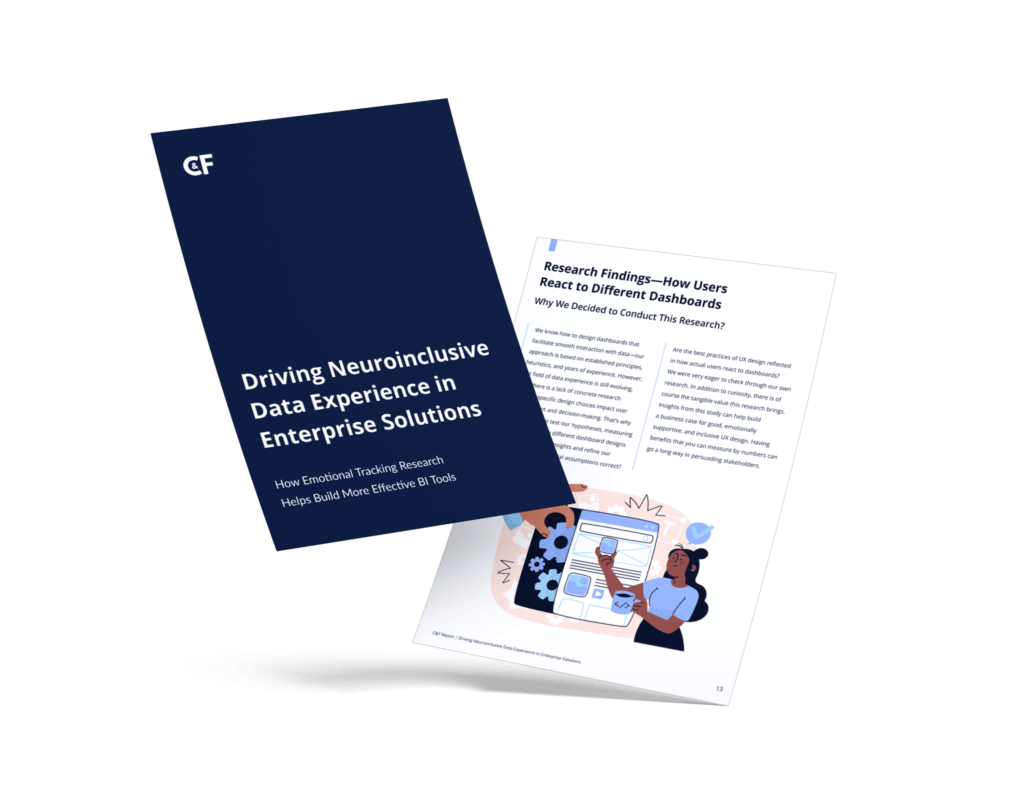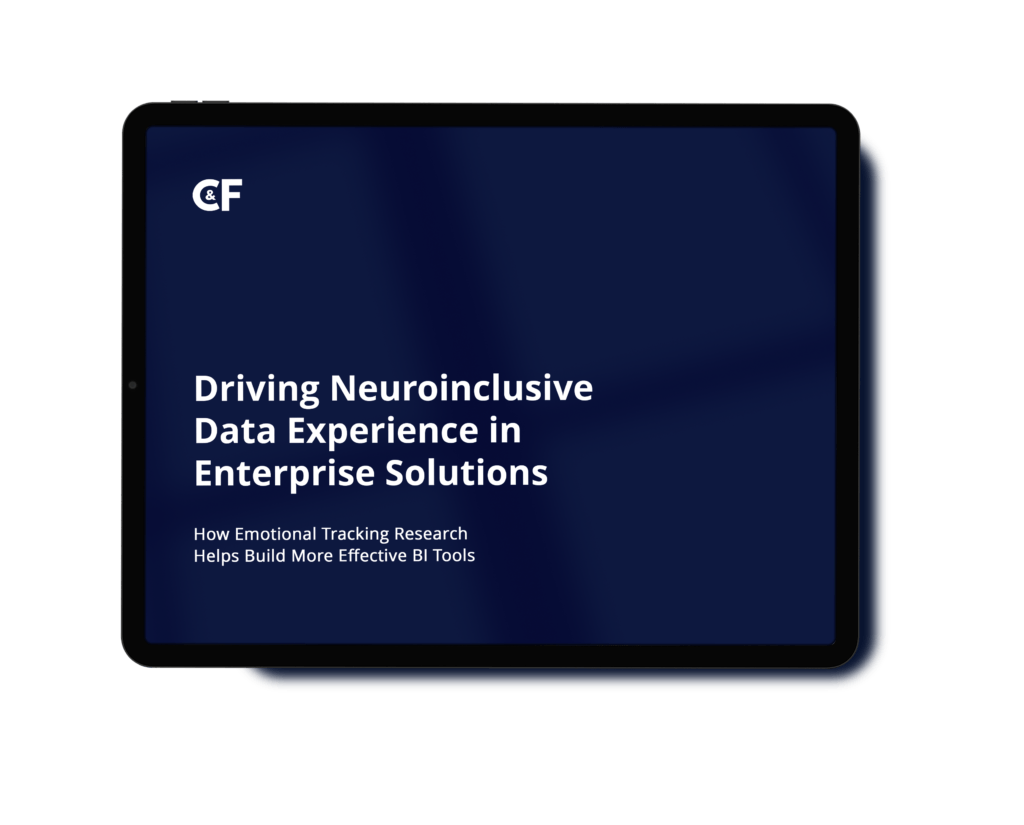Neurodiversity is gaining more attention in the workplace, and for good reason. In the U.S., up to 17% of the workforce identifies as neurodivergent, yet many enterprise environments still aren’t fully designed to support their strengths. As a result, businesses miss out on highly skilled, innovative thinkers who bring fresh perspectives to problem-solving, data analysis, and creative tasks. Unlocking the potential of these employees is entirely possible!
Forward-thinking companies like EY and Deloitte are already investing in neuroinclusivity, not just as a diversity initiative, but as a way to unlock untapped potential and drive better business outcomes.
At C&F, we’ve explored how neurodivergent professionals interact with data-heavy tasks using eye-tracking, face-tracking, and interviews. The insights from our research highlight practical ways companies can build more inclusive, high-performing environments. Later in this article, I will share more details about our study and the key takeaways that can help enterprises design better, neuroinclusive solutions. You can also access the full research report by clicking the link below.

In this article, we’ll look at the key business benefits of neuroinclusivity and share actionable steps to make enterprise solutions work for everyone.
First Things First
From a medical standpoint, many neurodivergent conditions are classified as disorders — some even have the word “disorder” in their official names, such as:
- Autism Spectrum Disorder (ASD)
- Attention Deficit Hyperactivity Disorder (ADHD)
Because this article focuses on the strengths and business value of neurodiversity, we will refer to these as neurodivergent conditions, cognitive differences, or neurotypes, rather than using medical terms like “disorders.”
After all, being told that the way your brain works is a ‘disorder’ doesn’t exactly feel great, does it?
Why Neuroinclusivity Matters for Enterprises
Neurodiversity can bring significant business value. Neurodivergent employees often demonstrate exceptional strengths in areas like analytical thinking, creativity, pattern recognition, and problem-solving. These skills are increasingly vital for innovation-focused sectors such as technology, data analytics, and R&D.
Research from Deloitte indicates that embracing neurodiversity can unlock valuable perspectives, fostering innovation and performance within teams.
According to Ludmila N. Praslova of Harvard Business Review, autistic professionals can be up to 140% more productive than typical employees when properly matched to their roles. In her article, she highlights research confirming that neurodivergent employees often demonstrate exceptional strengths, including understanding complex patterns, independently maintaining focus on tasks, reliability, and loyalty—qualities highly valued by organizations.
Incorporating neurodivergent talent into the workplace is not a new thing among market leaders. For instance, SAP’s Autism at Work program has led to notable improvements in software quality, data management, and customer experiences. Microsoft and Dell Technologies have been carrying similar programs for several years.
Neurodivergent professionals frequently bring unique strengths like meticulous attention to detail, superior analytical thinking, and fresh problem-solving approaches.
However, unlocking this potential requires more than just inclusive hiring practices of neurodivergent-friendly companies. By designing workspaces, tools, and processes that cater to diverse cognitive styles, enterprises not only support neurodivergent team members but also create environments that enable all employees to perform at their best.
One crucial aspect of creating a neuroinclusive workplace is ensuring that employees have access to well-designed digital tools and interfaces that accommodate different cognitive styles. At C&F, we explored this in our research, analyzing how neurodivergent professionals interact with data-heavy tasks.
Insights from C&F’s Research
As part of our commitment to improving user experience in data-driven environments, we conducted a study to measure emotional and cognitive responses to complex analytical tasks. Our goal was to verify best practices in UX design and assess how different users interact with digital tools. By leveraging methods like eye-tracking, face-tracking, and structured interviews, we analyzed user interactions with information and technology. Our research examined how different cognitive types respond emotionally and cognitively to data visualization, interactive dashboards, and analytical tasks. This approach allowed us to pinpoint practical aspects of user experience design that enterprises often overlook—but which can significantly influence employee performance and comfort.
Neurodivergent professionals made up 36% of the study group, allowing us to gain valuable insights into how UX design impacts diverse cognitive styles.
What Did We Discover?
- Users, including neurodivergent participants, experienced significant differences in engagement and frustration depending on UX design. Poorly optimized dashboards led to higher levels of frustration, confusion, and cognitive overload, particularly among neurodivergent users.
- Certain visual elements commonly used in enterprise dashboards and analytics tools negatively affected all users but had a disproportionately strong impact on neurodivergent professionals. High cognitive load, lack of clear labels, and excessive visual clutter made it harder to process data, leading to disengagement.
- Simple design adjustments significantly improved engagement and performance—highlighting the importance of inclusive UX design tailored to neurodiverse teams.
How Did We Conduct the Research?
Our study combined several methods to obtain a comprehensive understanding:
- Eye-tracking: capturing where and how participants focus visually on dashboards and interfaces.
- Face-tracking: analyzing emotional responses and engagement levels during interaction with data-intensive tasks.
- Interviews: collecting qualitative feedback directly from neurodivergent individuals to validate our observations.
Detailed findings and actionable recommendations for implementing neuroinclusive practices are presented in our comprehensive report. Enterprises aiming to harness the full potential of their teams can use these insights to design solutions that support diverse cognitive styles.
Our findings underscore that even small adjustments in workplace design, tools, and leadership approaches can significantly enhance neurodivergent employees’ experience. How can businesses take action?
Practical Steps for Implementing Neuroinclusivity
Creating a truly neuroinclusive environment requires intentional adjustments—not just good intentions. Here are practical steps enterprises can take to ensure their workplaces genuinely embrace cognitive diversity:
Workplace Adjustments
- Sensory-friendly workspaces
Provide quiet zones, adjustable lighting, noise-reduction solutions, and spaces designed to minimize sensory overload. - Flexible work arrangements
Allow options like remote or hybrid work, flexible hours, and personalized routines, enabling neurodivergent employees to perform at their peak. - Clear and structured communication
Provide detailed agendas before meetings, summarize action points afterward, and encourage clarity and directness in internal communications.
Technology & UX Design
- Adopt neuroinclusive UX principles in enterprise software, dashboards, and visualization tools.
- Prioritize simplicity, consistency, and customization—allowing users to adapt interfaces according to their sensory and cognitive needs.
- Consider factors such as sensory overload by creating dashboards and interfaces that minimize distractions, optimize readability, and reduce cognitive overload.
Leadership & Employee Training
- Educate leaders and managers about neurodiversity to enhance their awareness and management skills.
- Implement regular training sessions focused on neuroinclusivity, helping managers recognize strengths and effectively support neurodivergent employees.
- Foster a culture of openness, where neurodivergent team members feel comfortable communicating their needs and sharing ideas freely.
These measures aren’t just helpful—they’re essential for building teams that leverage the full range of cognitive strengths available within their talent pool.
Designing the Future of Work
Neuroinclusivity is no longer just a nice-to-have; it’s a business imperative. Companies that actively embrace neurodivergent talent don’t only promote fairness and inclusivity, they also unlock powerful competitive advantages in productivity, innovation, and workplace satisfaction. The question isn’t whether enterprises can afford to implement neuroinclusive strategies, but rather, can they afford not to?
At C&F, we believe that the future of work is one that values and leverages diverse cognitive strengths. By designing neuroinclusive enterprise solutions, neurodivergent-friendly companies can create environments where everyone, regardless of cognitive style, can excel and thrive.
For deeper insights and actionable strategies, explore our full report titled Driving Neuroinclusive Data Experience in Enterprise Solutions

Would you like more information about this topic?
Complete the form below.
